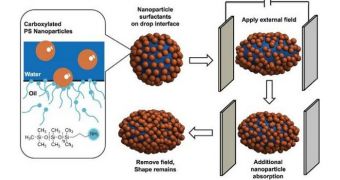A simple truth is shared among physicists, chemists, and cooks: oil and water do not mix at all. However, a new study conducted at the University of Massachusetts demonstrates that oil can act as a support for water drops, enabling scientists to apply a newly-developed technique for changing the shape of said drops from spherical to oval.
This was demonstrated by polymer scientist Tom Russell, who is now a visiting professor at the DOE Lawrence Berkeley National Laboratory's Materials Sciences Division. He used oil, magnetic fields, and nanoparticle surfactants to turn spherical drops of water into ellipsoids, glass wool-like fibrous structures, and even tubes.
“Using the in situ formation of nanoparticle surfactants on a water drop that’s been suspended in oil, we’ve demonstrated a simple route to produce and stabilize fluid drops having shapes far removed from their equilibrium spherical shape,” the investigator explains, saying that silicone oil was used for these studies.
Stabilizing any natural structure in a state of non-equilibrium is extremely difficult, and ever more so for liquids, but it would now seem that nanoparticles and magnetic fields can do this for water. This technique could lead to the creation of new drug-delivery mechanisms, advanced microfluidic devices, or even all-liquid batteries for electronic devices.

 14 DAY TRIAL //
14 DAY TRIAL //